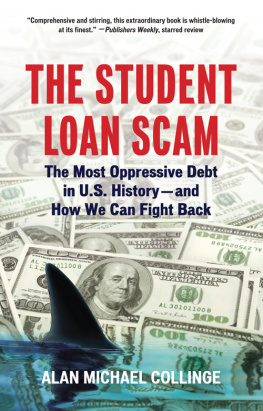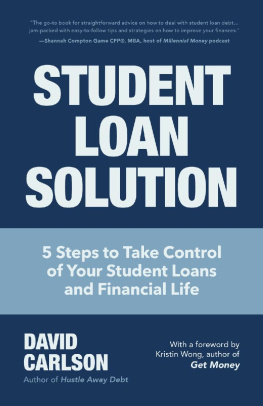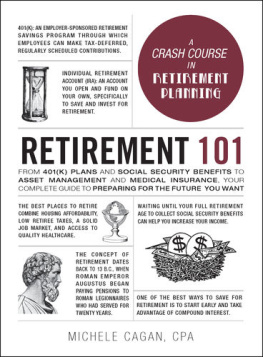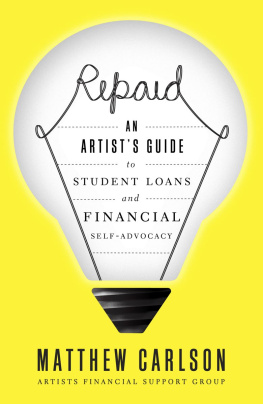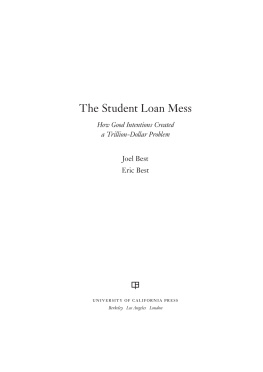
Dedicated to my mother and father, and to student loan borrowers everywhere
Contents
CHAPTER ONE
The Rise of Sallie Mae and the Fall of Consumer Protections
CHAPTER TWO
Who Benefited
CHAPTER THREE
Collection Abuses
CHAPTER FOUR
The Borrowers
CHAPTER FIVE
The Oversight Fiasco
CHAPTER SIX
The Corruption of the Universities
CHAPTER SEVEN
The Grass Roots Awaken
CHAPTER EIGHT
Solutions
CHAPTER NINE
Practical Advice for Borrowers
Preface
Being the poster child for defaulted student borrowers is a difficult job to haveand I never imagined Id be known as the crusader for student loan justice. The truth is that I never considered student loans to be an especially interesting topic. College debt, I believed, was a necessary evilto be repaid expeditiously and then forgotten even more quickly. However, what I once thought of as an uninteresting issue has come to dominate my life.
Over the course of earning three degrees in aerospace engineering at the University of Southern California, I managed to accumulate about thirty-eight thousand dollars in student loans. In 1998, when I graduated, these loans had grown to fifty thousand dollars, and I consolidated them with a friendly-sounding organization called Sallie Maean organization that at the time I believed was part of the federal government.
My plan was simple: graduate with a bulletproof education, get a fine job in my field, repay my loans, and let life blossom beyond that. I yearned for a simple, middle-class lifea wife, a family, and a house; typical cultural aspirations that I shared with most of the people in the blue-collar town in the Pacific Northwest where I grew up.
In late 1998, I found a job at an exceptionally good college, Caltech, as an aeronautical research scientist. The salary wasnt high, but, at thirty-five thousand dollars, it did just cover my rent; food; basic necessities, like a car and utilities; and my monthly student loan payment, which amounted to about 20 percent of my take-home pay.
In early 1999, I was slightly short on my student loan payment. I called the lender and was assured that as long as I continued to make my regularly scheduled payments, all would be well, with the exception of a one-time late fee on the account.
I continued to make regular payments; however, after around six months, I noticed that I had been charged a late fee every month since the initial underpayment. Assuming that this was a mistake, I called Sallie Mae and requested that the late fees be removed. To my surprise, they refused. I spoke to multiple Sallie Mae staff members, to no avail. It was then that I realized that Sallie Mae was not a government entity but, rather, a for-profit corporation. I searched for a different lender to take over my loans but found that these loans could not be refinancedit was actually illegal to do so because of federal regulations that permit the consolidation of student loans one time only, whether or not there are other lenders willing to offer better terms on the loan.
It was becoming harder to keep up with my loan payments. My rent had increased, my utility costs had more than doubled, and a number of relatively small but significant unforeseen expenses had cropped up. By the summer of 2001, my financial situation had reached a critical state, and I decided to take radical steps to solve this problem. I resigned my position at Caltech, expecting to find a higher-paying position quickly, probably in the defense industry. Unfortunately, the events of September 11 put a chill on the economy, and instead of having a six-figure defense job, I was unemployed and surviving on a small retirement package. In retrospect, leaving Caltech without a job lined up was a big mistake, one that I will live with for the rest of my life.
I soon returned to my hometown of Tacoma, Washington. Nearly penniless, I slept on a friends couch. I realized that my student loans were approaching default, and, on December 1, 2001, I applied for an economic-hardship forbearance. After all, I was unemployed; I should qualify. I didnt hear anything from Sallie Mae, and when I called a few days later, they claimed they had never received my application. I resubmitted the request. On December 13, Sallie Mae denied that request, and on December 14the very next daythey put my loan in default. Nine days later, they made a payment claim for my loan for about sixty thousand dollars. I never received any notice from Sallie Mae explaining this. Calls to them garnered only the response Youll have to call your guarantor. We no longer hold this loan.
I didnt realize then that it would be nearly two years before I found gainful employment. In the meantime, I took whatever kind of job I could find. I worked in five restaurants, and in 2002 I even spent four months cooking on a remote island in southeastern Alaska. I worked ninety-two hours a week, seven days a week, with no days off. My income, less than minimum wage, was not even close to covering the growth of my now-defaulted student loans. Sixteen months after Sallie Mae had defaulted my loans, a whopping eighteen thousand dollars had been added to my debt, far more than I had made during that time period. In the fall of 2002, when I returned from Alaska, I was shocked to find a bill from a collection company, General Revenue Corporation, for nearly eighty thousand dollars. The company, a subsidiary of Sallie Mae, was collecting on behalf of EdFund, the guarantor. I was baffled: Who were these two new companies, and what was a guarantor? I wasnt in a position to ask a wealthy relative for assistance, and the fact that the company was demanding immediate payment in full greatly increased my apprehension.
This began two years of relentless collection activities. I was inundated with calls from various collection companies, and at the same time, I was contacting my loan holders and attempting to negotiate a reasonable settlement. I tried Sallie Mae first, then EdFund and the various collection companies they used, and finally the U.S. Department of Education. I told them Id repay the principal and accrued interest and even offered to pay at an increased interest rate of 10 percent if only they would remove some of the penalties. I believed that I was proposing a rather lucrative settlement; Sallie Mae had already made well over twenty-five thousand dollars on my original thirty-eight-thousand-dollar loanwhy should they need more?
However, at every step along the way, I was refused. I found that I had no negotiation power whatsoever for my student loan debts: bankruptcy does not eliminate them, statutes of limitations do not exist for them, and the standard consumer protections on other types of debt do not apply. Meanwhile, my loan balance was exploding.
Most of the interactions, particularly with the collection companies, were unpleasant, to say the least. I was verbally assaulted, intimidated, and humiliated. I was called names that I have since suppressed in my memory. I was subjected to all manner of collection ploys designed to extract vast sums of money from me that I simply did not have.
It became apparent that I had been snared in a web of debt, the amount of which was now so far above what I had initially borrowed that it meant, in effect, a lifetime of indentured servitude. At this point I had a job at a nonprofit company and was making about three thousand dollars a month, but my debt had risen to nearly ninety-five thousand dollars. One day, at the age of thirty-three, I soberly recognized that my hopes for marriage, children, and a home were much farther away from being realized than they had been when I was twenty-nine, solely because of my mushrooming student loan debt.

